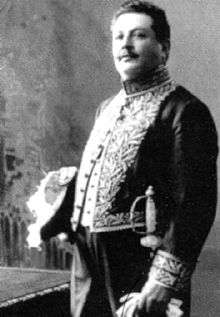Bautista Saavedra
| Bautista Saavedra | |
|---|---|
 | |
| 35th President of Bolivia | |
|
In office 28 January 1921 – 3 September 1925 | |
| Preceded by | José Gutiérrez Guerra |
| Succeeded by | Felipe Segundo Guzmán |
| Personal details | |
| Born |
Bautista Saavedra Mallea 30 August 1870 Sorata, La Paz, Bolivia |
| Died |
1 May 1939 (aged 68) Santiago, Chile |
| Nationality | Bolivian |
| Political party | Socialist Republican Party |
| Occupation | |
Bautista Saavedra Mallea (30 August 1870 in Sorata – 1 May 1939)[1] was President of Bolivia, first as part of a governing junta between 1920–21, and then as constitutionally-elected President of the Republic between 1921 and 1925.
As leader of the insurgent Republican Party, he instigated and led the coup d'état of 1920 against the long-ruling Liberal Party of President José Gutiérrez Guerra. He had a turbulent term, as his party fragmented almost immediately after the coup, with a large fraction of it going on to form the Partido Republicano-Genuino (Genuine Republican party). Essentially, the split was due to opposition to the largely personalist, centralized, and caudillo-like governing style of Saavedra. He quickly expelled from the country most top-leaders of the Genuino party, and often made use of extra-constitutional means to remain in power.
Unable to run for re-election in 1925, Saavedra did the next best thing and made sure a hand-picked successor would follow him, presumably one firmly under his thumb. His first choice, Gabino Villanueva, failed to be sufficiently pliable for the President's liking, and Saavedra annulled the 1925 elections on a technicality. Nationwide protests at this transparent effort to manipulate the elections and prolong Saavedra's stay in office forced the President to resign, leaving in his place Felipe Segundo Guzmán, the President of the Senate. The latter, clearly a "Saavedra's man," called elections for 1926.
Saavedra thus renewed his quest to find the ideal proxy candidate through which to rule. He found the perfect man in Hernando Siles, who ran in the elections along with Bautista Saavedra's own brother, Abdón Saavedra, as his Vice-Presidential running mate. This allowed the meddling former President to continue to run the strings of the Bolivian government—or so he thought, for President Siles eventually tired of Saavedra's heavy-handed meddling and exiled him along with his brother (his own Vice-President).
Saavedra remained an influential political leader after that, but never returned to power, especially since his arch-rivals of the Partido Republicano Genuino finally gained power in 1930. He died while exiled in Chile on May 1, 1939.
The province of Bautista Saavedra Province was named after this former President. Its capital is Charazani.
References
External links
| Political offices | ||
|---|---|---|
| Preceded by José Gutiérrez Guerra |
President of Bolivia 1921–1925 |
Succeeded by Felipe Segundo Guzmán |